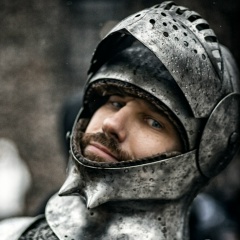Перечитывал Окшотта, наткнулся на цитату:
"Мечи в две руки.
Двуручники весьма привлекательны для романтиков и маленьких мальчиков, но это не практичный вид оружия, не являющийся также и красивым по форме.Большинство сохранившихся образцов просто безобразны, и лишь немногие, относящиеся к ранним формам периода 140-1540 года, могут быть очень красивыми. Его корни относятся к тринадцатому веку; есть один или два очень больших меча, которые можно датировать временем между 1250 и 1300 годом и которые описаны эпитетом "Twahandswerds", но являются лишь обычными военными мечами (тип 13а) лишь большего размера." Ewart Oakshott, European weapons and armour from the rennaissance to industrial revolution, Woodbridge, 2000, P.146
"Мечи в две руки.
Двуручники весьма привлекательны для романтиков и маленьких мальчиков, но это не практичный вид оружия, не являющийся также и красивым по форме.Большинство сохранившихся образцов просто безобразны, и лишь немногие, относящиеся к ранним формам периода 140-1540 года, могут быть очень красивыми. Его корни относятся к тринадцатому веку; есть один или два очень больших меча, которые можно датировать временем между 1250 и 1300 годом и которые описаны эпитетом "Twahandswerds", но являются лишь обычными военными мечами (тип 13а) лишь большего размера." Ewart Oakshott, European weapons and armour from the rennaissance to industrial revolution, Woodbridge, 2000, P.146
I reread Oakeshott, came across a quote:
"Swords in two hands.
Two-handed are quite attractive to romantics and little boys, but they are not a practical weapon, nor are they beautiful in shape. Most of the surviving examples are simply ugly, and only a few, dating back to the early forms of the period 140-1540, can be very beautiful. Its roots date back to the thirteenth century; there are one or two very large swords that can be dated between 1250 and 1300 and which are described with the epithet "Twahandswerds", but are just regular military swords (type 13a) only of a larger size. "Ewart Oakshott, European weapons and armor from the rennaissance to industrial revolution, Woodbridge, 2000, P.146
"Swords in two hands.
Two-handed are quite attractive to romantics and little boys, but they are not a practical weapon, nor are they beautiful in shape. Most of the surviving examples are simply ugly, and only a few, dating back to the early forms of the period 140-1540, can be very beautiful. Its roots date back to the thirteenth century; there are one or two very large swords that can be dated between 1250 and 1300 and which are described with the epithet "Twahandswerds", but are just regular military swords (type 13a) only of a larger size. "Ewart Oakshott, European weapons and armor from the rennaissance to industrial revolution, Woodbridge, 2000, P.146

У записи 27 лайков,
1 репостов,
1277 просмотров.
1 репостов,
1277 просмотров.
Эту запись оставил(а) на своей стене Андрей Богданов
















































